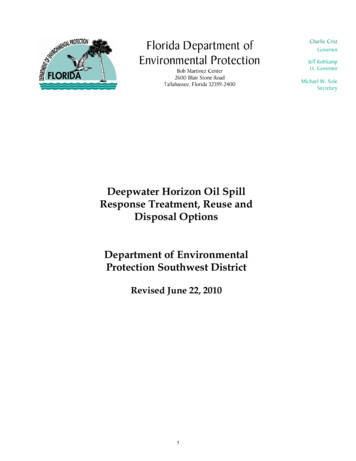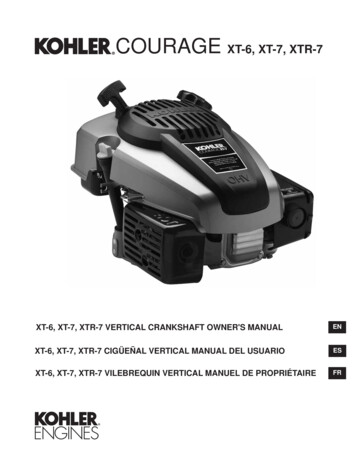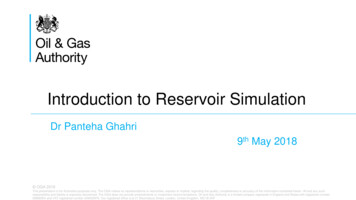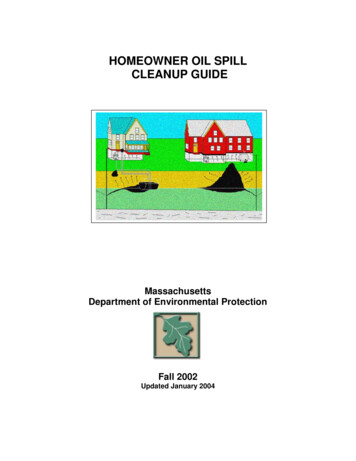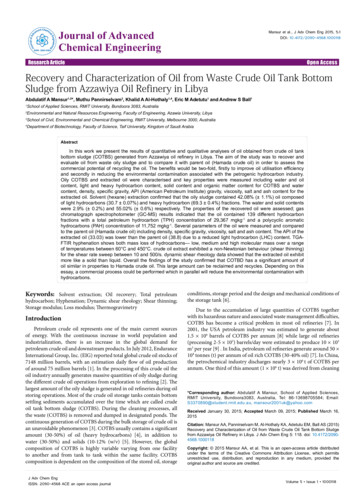
Transcription
urnal of AdvJoineerinEnggalced ChemicanISSN: 2090-4568Journal of AdvancedChemical EngineeringMansur et al., J Adv Chem Eng 2015, 5:1DOI: 10.4172/2090-4568.1000118Research ArticleOpen AccessRecovery and Characterization of Oil from Waste Crude Oil Tank BottomSludge from Azzawiya Oil Refinery in LibyaAbdulatif A Mansur1,2*, Muthu Pannirselvam3, Khalid A Al-Hothaly1,4, Eric M Adetutu1 and Andrew S Ball11School of Applied Sciences, RMIT University, Bundoora 3083, Australia2Environmental and Natural Resources Engineering, Faculty of Engineering, Azawia University, Libya3School of Civil, Environmental and Chemical Engineering, RMIT University, Melbourne 3000, Australia4Department of Biotechnology, Faculty of Science, Taif University, Kingdom of Saudi ArabiaAbstractIn this work we present the results of quantitative and qualitative analyses of oil obtained from crude oil tankbottom sludge (COTBS) generated from Azzawiya oil refinery in Libya. The aim of the study was to recover andevaluate oil from waste oily sludge and to compare it with parent oil (Hamada crude oil) in order to assess thecommercial potential of recycling the oil. The benefits would be two-fold, firstly to improve oil utilisation efficiencyand secondly in reducing the environmental contamination associated with the petrogenic hydrocarbon industry.Oily COTBS and extracted oil were characterised and key properties were measured including water and oilcontent, light and heavy hydrocarbon content, solid content and organic matter content for COTBS and watercontent, density, specific gravity, API (American Petroleum Institute) gravity, viscosity, salt and ash content for theextracted oil. Solvent (hexane) extraction confirmed that the oily sludge contained 42.08% ( 1.1%) oil composedof light hydrocarbons (30.7 0.07%) and heavy hydrocarbon (69.3 0.4%) fractions. The water and solid contentswere 2.9% ( 0.2%) and 55.02% ( 0.6%) respectively. The properties of the recovered oil were assessed; gaschromatograph spectrophotometer (GC-MS) results indicated that the oil contained 139 different hydrocarbonfractions with a total petroleum hydrocarbon (TPH) concentration of 29,367 mgkg-1 and a polycyclic aromatichydrocarbons (PAH) concentration of 11,752 mgkg-1. Several parameters of the oil were measured and comparedto the parent oil (Hamada crude oil) including density, specific gravity, viscosity, salt and ash content. The API of theextracted oil (33.03) was lower than the parent oil (38.8) due to a reduced light hydrocarbon (LHC) content. TGAFTIR hyphenation shows both mass loss of hydrocarbons— low, medium and high molecular mass over a rangeof temperatures between 60 C and 450 C. crude oil extract exhibited a non-Newtonian behaviour (shear thinning)for the shear rate sweep between 10 and 500/s. dynamic shear rheology data showed that the extracted oil exhibitmore like a solid than liquid. Overall the findings of the study confirmed that COTBD has a significant amount ofoil similar in properties to Hamada crude oil. This large amount can be reclaimed and recycles. Depending on thisessay, a commercial process could be performed which in parallel will reduce the environmental contamination withhydrocarbons.Keywords: Solvent extraction; Oil recovery; Total petroleumhydrocarbon; Hyphenation; Dynamic shear rheology; Shear thinning;Storage modulus; Loss modulus; ThermogravimetryIntroductionPetroleum crude oil represents one of the main current sourcesof energy. With the continuous increase in world population andindustrialization, there is an increase in the global demand forpetroleum crude oil and downstream products. In July 2012, EnduranceInternational Group, Inc. (EIG) reported total global crude oil stocks of7148 million barrels, with an estimation daily flow of oil productionof around 75 million barrels [1]. In the processing of this crude oil theoil industry annually generates massive quantities of oily sludge duringthe different crude oil operations from exploration to refining [2]. Thelargest amount of the oily sludge is generated in oil refineries during oilstoring operations. Most of the crude oil storage tanks contain bottomsettling sediments accumulated over the time which are called crudeoil tank bottom sludge (COTBS). During the cleaning processes, allthe waste (COTBS) is removed and dumped in designated ponds. Thecontinuous generation of COTBS during the bulk storage of crude oil isan unavoidable phenomenon [3]. COTBS usually contains a significantamount (30-50%) of oil (heavy hydrocarbons) [4], in addition towater (30-50%) and solids (10-12% (w/v) [5]. However, the globalcomposition of COTBS is highly variable varying from one facilityto another and from tank to tank within the same facility. COTBScomposition is dependent on the composition of the stored oil, storageJ Adv Chem EngISSN: 2090-4568 ACE an open access journalconditions, storage period and the design and mechanical conditions ofthe storage tank [6].Due to the accumulation of large quantities of COTBS togetherwith its hazardous nature and associated waste management difficulties,COTBS has become a critical problem in most oil refineries [7]. In2001, the USA petroleum industry was estimated to generate about1.5 106 barrels of COTBS per annum [8] while large oil refineries(processing 2-5 105) barrels/day were estimated to produce 10 103m3 per year [9] . In India, petroleum oil refineries generate around 50 103 tonnes (t) per annum of oil rich COTBS (30-40% oil) [7]. In China,the petrochemical industry discharges nearly 3 106 t of COTBS perannum. One third of this amount (1 106 t) was derived from cleaning*Corresponding author: Abdulatif A Mansur, School of Applied Sciences,RMIT University, Bundoora3083, Australia, Tel: 86-13698705584; Email:S3370890@student.rmit.edu.au, mansour2001uk@yahoo.comReceived January 30, 2015; Accepted March 09, 2015; Published March 16,2015Citation: Mansur AA, Pannirselvam M, Al-Hothaly KA, Adetutu EM, Ball AS (2015)Recovery and Characterization of Oil from Waste Crude Oil Tank Bottom Sludgefrom Azzawiya Oil Refinery in Libya. J Adv Chem Eng 5: 118. doi: 10.4172/20904568.1000118Copyright: 2015 Mansur AA, et al. This is an open-access article distributedunder the terms of the Creative Commons Attribution License, which permitsunrestricted use, distribution, and reproduction in any medium, provided theoriginal author and source are credited.Volume 5 Issue 1 1000118
Citation: Mansur AA, Pannirselvam M, Al-Hothaly KA, Adetutu EM, Ball AS (2015) Recovery and Characterization of Oil from Waste Crude Oil TankBottom Sludge from Azzawiya Oil Refinery in Libya. J Adv Chem Eng 5: 118. doi: 10.4172/2090-4568.1000118Page 2 of 11operations associated with crude oil storage tanks [10]. In parallel withoil refineries, oilfields also generate significant amounts of COTBS. In2010, Shengli Oilfield alone discharged more than 10 104 t of COTBS[11].The accumulation of COTBS inside the oil tanks reduces their oilstoring capacities and introducing the oily sludge into the refinerycan ultimately disturb the refining processes [12]. In contrast, spillingof COTBS in the environment without treatment poses a significantrisk to the surrounding environment and population. Importantly,prolonged storage of COTBS in accumulation ponds leads to seepageand contamination of ground water as well as the reduction in the light(volatile) fractions. Many of these volatile compounds are known ofsuspected carcinogens and mutagens and their release into the air posesa significant threat to the ecosystem and human population. Moreover,If COTBS is disposed of inappropriately, the oily sludge will splash intothe soil where hundreds of individual compounds will contaminatethe soil [11,13,14]. As many of COTBS hydrocarbon components areconsidered as toxic, mutagenic or carcinogenic [15], in 1992 the UnitedStates Environmental Protection Agency (US EPA) announced a finalrule (57 FR 37194, 37252) stating treatment regulations and standardsunder the land disposal restrictions program for several hazardouswastes including hydrocarbon materials (COTBS) [16].COTBS is continuously generated and disposed of in large quantities[17]. Recently, development of treatment strategies for COTBS to reducetheir environmental burden has received increased global attention [4]and different effective remediation techniques have been proposed[17] including physical, chemical and biological methods. Among thetechniques described, landfilling, incineration, microwave liquefaction,centrifugation, encapsulation, biodegradation in landfarming, biopilesand bioreactors have all featured [18]. However, some methods (e.g.incineration) have become restricted in some countries through theimplementation of rigorous environmental standards because of theirpotential environmental impact [19].Given the high hydrocarbon content of the oily COTBS, theconventional treatment methods such as land farming, landfillingand incineration are time-consuming, ineffective, expensive andmay potentially release more unwanted environmental pollutants[20,21]. Also as oily COTBS is recognized as a potentially valuableenergy resource, decomposition (bioremediation) techniques usingmicroorganisms are also inadvisable [21]. The current driving forcefor increased interest in studying and characterising the COTBS are torecover oil from waste oily sludge in order to assess the commercialpotential of recycling the oil. The benefits would be two-fold,firstly to improve oil utilisation efficiency and secondly in reducingthe environmental contamination associated with the petrogenichydrocarbon industry [22,23].To characterise and classify recovered oil for commercial use,its physiochemical properties should be known. To classify theoil, the API gravity is the most important property. It is the relativedensity of the petroleum liquids and the density of water, and used tocompare the relative densities of petroleum products. API is a scalefor denoting the 'lightness' or 'heaviness' of petroleum crude oilsand products. The lighter hydrocarbon the higher API gravity andthe lighter hydrocarbon the higher market value. Oils with API morethan 30 are known as light while oils in the range between 22 and30 are medium, but API less than 22 are heavy and below 10 areextra heavy. It is preferable to between 25 and 30 [24]. In additionto the density, the viscosity which is the resistance to flow is anotherimportant factor that affects the pumping and transportation abilitiesJ Adv Chem EngISSN: 2090-4568 ACE an open access journalthrough the pipelines. Dealing with high viscosity oil is one of themain difficulties in transportation through the piping network [25].Usually the viscosity of hydrocarbon oils ranges from 100 mPa to 105mPa and the maximum desired viscosity is 400 mPa [26], but the highviscosity can be reduced to the desired value by reducing the liquidtemperature by adding gaseous or liquid diluents [25]. In addition,flash point which is the minimum temperature at which the vapoursof the material can ignite is the indicator of the flammability of thehydrocarbon oils. Safe handling of oils including processing, storage andtransportation needs knowing the accurate values of flash point [27].Moreover; presence of ash in the oil can affect the quality of oil. The ashcontent provides knowledge of metallic constituent left after completecombustion of the oil under specific condition. High ash content lowersthe heating values and it is undesirable for direct combustion due tofouling and slagging [28]. Usually the petroleum crude oil containsa small amount of salts expressed as the presence of NaCl. If the saltcontent is higher the 1000bbl, the salt need to be minimized to reducethe fouling and corrosion in addition to the formation of acids by saltschlorides [29].Therefore this work aims to assess the quality of recovered oil fromwaste oily sludge and to compare it with parent oil (Hamada crude oil)for recycling purposes and (ii) to reduce the environmental impact ofCOTBS by reducing the oil content of the soil to the minimum possiblelevels.Materials and MethodsCharacterization of sludgePetroleum-based COTBS samples used for this study were obtainedfrom collection lagoons at Azzawiya oil refinery in Libya. Aftercollection, the sludge samples were kept at room temperature for theduration of the study. The sludge was mixed well manually before eachsample was taken.Water content (wt%): The water content of the COTBS sampleswas measured as indicated by the American Society for Testing andmaterials (ASTM) standard method (D95). COTBS samples (25 g, intriplicate) were taken and placed in an extraction thimble and 75 ml ofdichloromethane (DCM) (solvent) were added (1:3 soil: solvent ratio)[30].The oil, solvent and water were then distilled and the condensate(water and solvent) continuously separated in a trap and transferred toa graduated cylinder. The triplicate condensates were pooled together[31]. It should be noted that due to the density of water (1g/cm3) beingless than the density of solvent, the solvent layer settled at the bottom ofthe separation funnel and was measured.Volatile hydrocarbons and moisture content (wt%): Volatilehydrocarbons (VH) and moisture content of the COTBS samples weredetermined in triplicate by weighing (8 g) in ceramic crucibles andheating to 105 C in a ventilated incubator for 24 h. The lost mass wasattributed to light volatile hydrocarbons and moisture content [32].The light volatile hydrocarbons were calculated using the followingequation:reduced mass ( g )Light hydrocarbons 100%-watermass of tested sample ( g )content (%)(1)Solid content (wt%): Solid materials (sediment, ash and organic)content were measured according to the method described by [2]with some adjustments. After measuring the light hydrocarbons andmoisture content, the dried COTBS samples (at 105 C) were heated ina muffle furnace (LABEC, Laboratory Equipment. Pty Ltd, Australia)Volume 5 Issue 1 1000118
Citation: Mansur AA, Pannirselvam M, Al-Hothaly KA, Adetutu EM, Ball AS (2015) Recovery and Characterization of Oil from Waste Crude Oil TankBottom Sludge from Azzawiya Oil Refinery in Libya. J Adv Chem Eng 5: 118. doi: 10.4172/2090-4568.1000118Page 3 of 11to 550 C for 30 min [32] and the remaining samples re-weighed. Thesolid (sediment and ash) content of the COTBS was calculated usingthe following equation:Solid content reduced mass ( g )mass of tested sample ( g ) 100%(2)Organic matter content: The organic matter concentration wasmeasured by loss on ignition of dry solid material in the muffle furnace(550 C for 30 min). The mass that was lost by the sample was attributedto organic material.Non-volatile hydrocarbons content (wt%): Non-volatilehydrocarbons (NVH) was calculated according to [32] using thefollowing equations:NVH 100%-VH SC WC(3)Where: NVH is non-volatile hydrocarbons (wt%)VH is volatile hydrocarbons (wt%)SC is solid content (wt%)WC is water content (wt%)Oil recovery: Oil was recovered from 6 sludge samples by solventextraction (dichloromethane (DCM)) using a previously describedprotocol [30]. Briefly, a known amount (74.3 g, 76.1 g, 71.00 g, 67.5 g,70.6 g and 67.1 g) of COTBS samples were weighed at room temperatureand placed in Teflon coated (250 ml) centrifuge tubes and (DCM) wasadded (1:1 soil: solvent ratio). The oil in this mixture was extracted byagitation (130 rev min-1) for 30 min, followed by centrifugation at 5000rev min-1 for 5 min. The supernatants containing oil and solvent wereremoved and collected into glass bottles (500 ml).Solvent recovery: To concentrate the reclaimed oil, the solvent(DCM) soluble fraction was rotary evaporated (250 ml a time) in aBuchi 461 water bath (Buchi RE111 Rotavapor, Buchi, Switzerland) at40 C. The remaining oil was measured and reported as the volume ofoil content in the COTBS and prepared for further analysis [33,34].Characterization of recovered oilDetermination of hydrocarbon fractions concentration: For theanalysis of hydrocarbons fractions within the recovered oil, includingaromatic and aliphatic compounds, a combined paraffins, isoparaffins,aromatic, naphthalenes and oleffins (PIANO) PIANO-5-Piano (DHA)standard combined set (2 ml ampule) (Spectrum Quality Standards,Ltd. Sugarland, TX, USA) was used. The hydrocarbon content of theextracted oil was analysed as described in ASTM D513 [30] usinggas chromatograph mass spectrometer (GC-MS) equipped withautosampler (Aglient 6890 GC and Leco Pegasus III TOF-MS). Sampleswere injected and separated on a capillary column Agilent DB-5MS (60m by 0.25 mm with 0.25 µm film thickness). The injection temperatureand volume was 225 C and 0.2 µl respectively. Helium (1.8 ml min-1)was used as a carrier gas at a constant flow rate. The concentration ofeach hydrocarbon fraction was analyzed and the total peak area of eachfraction was compared to the peak area of each fraction in the PIANOstandard curve [35].Density: The density (ρ) of extracted oil was estimated by dividinga known mass of the oil to its volume. Briefly, 10 ml of the recoveredoil was measured and weighed (Mettler AE 260, Mettler-Toledo,Switzerland). The density of the oil was derived from the followingequation:ρ mass / volumeJ Adv Chem EngISSN: 2090-4568 ACE an open access journal(4)Specific gravity: Specific gravity (SGtrue) is the ratio of the densityof a liquid to the density of water (g/l). The specific gravity of theclaimed oil was measured according to [36] and can be expressedmathematically from the following equation:SGtrue ( ñ sample ) / ( ñ H2O )(5)API gravity: API gravity was calculated using the specific gravity ofthe oil extract, a unit-less property and determined at 60 F. API gravitywas calculated according to [37] using the following equation:API gravity (141.5/Specific Gravity)-131.5(6)Viscosity: Viscosity (υ) was measured using a Cannon-Fenske(Fisher Scientific, Pittsburgh, PA) glass capillary kinematic viscometerin a constant temperature bath in accordance with ASTM D445.Kinematic viscosity is determined by measuring the time (t) for aknown volume of liquid flowing under gravity to pass through acalibrated glass capillary viscometer tube. The manufacturer of theCannon- Fenske type viscometer tubes supplied calibration constants(c) at a range of temperature 40 F and 100 F [38,39].Kinematic viscosity (υ) in centistoke (cSt) was calculated from thefollowing equation.υ c.t (7)Ash content: Ash content of the extracted oil was determined usinga loss-on-ignition procedure according to [40] with some adjustments.Triplicate samples (5 g) were heated overnight at 105 C and thentransferred to a muffle furnace held at 550 C for 30 min to burn theorganic matter. Ash content was calculated from the ratio of pre- andpost-ignition sample mass.Salt content: The salinity of the extracted oil was determined usingthe electrometric method according to ASTM D 3230 procedures usinga Pro 2030 multimeter (YSI Incorporation, Yellow Springs. OH 45387.USA). In this method, the sample was dissolved in a mixed solvent andplaced in a test cell consisting of a beaker and two parallel stainlesssteel plates. An alternating voltage was passed through the plates, andthe salt content was obtained by reference to a calibration curve of therelationship of salt content of known mixtures to the current [41,42].Thermogravimetric analysis (hyphenation with FTIRspectroscopy): The sample (COTBS extract) was used to measure massloss and to determine functional group of the sample at a given time andtemperature. Wilkie previously described a TGA/FTIR hyphenationtechnique that could be applied to investigate the degradation ofcrude oil extract [43]. Thermogravimetric analysis was performedon STA6000 operating under nitrogen with a flow rate of 20 ml/minthrough the furnace in the following conditions. A sample mass of 40 mg was heated in the crucible with heating rate of 20 C/min from50 to 950 C in an inert atmosphere (nitrogen). The gas evolving fromSTA6000 was transferred via gas transfer line. This transfer line allowsthe transfer of combustion of pyrolysis products from thermal analyserto FTIR 100 through the gas flow cell. Spectrum time base was used toanalyse the sp files collected during the testing to analyse the spectrum(collected continuously for over 3600 s).Shear rheology testing to measure viscosity: HR3 (HybridDiscovery) rheometer was used to measure the rheological propertiesof sample (COTBS extract). The instrument (HR3 rheometer) wascalibrated with viscosity standard including Polydimethyl Siloxane(PDMS). Crossover frequency of G’ and G” of calibration resultsmatched with the value recommended by instrument suppliers–TAinstruments. Shear rheology was conducted on the sample at a constantVolume 5 Issue 1 1000118
Citation: Mansur AA, Pannirselvam M, Al-Hothaly KA, Adetutu EM, Ball AS (2015) Recovery and Characterization of Oil from Waste Crude Oil TankBottom Sludge from Azzawiya Oil Refinery in Libya. J Adv Chem Eng 5: 118. doi: 10.4172/2090-4568.1000118Page 4 of 11temperature of 50 C and a constant strain of 1%, angular frequency of1 to 100 rad/s. Parallel plate geometry (40 mm smart swap, stainlesssteel) was used in this research. It should be noted that the sample wastested as received.Temperature Major compound evolving from the sample at that temperatureResultsComposition of the oily sludgeComposition of recovered oilIn addition to the amount of oil recovered, the quality of the oilhas a major influence on determining the commercial viability of therecycling process. Selected physiochemical properties of the recoveredoil from COTBS were tested including water content, organic material,density, specific gravity, API gravity, viscosity, salt content and ashcontent. The selected properties were compared with parent oilProperty %SludgeWater content2.9 0.2Oil content42.08 1.1Light hydrocarbons and moisture content in the recovered oil30.7 0.07Non-volatile hydrocarbons in the recovered oil69.3 0.4Solid content55.02 0.6Organic matter content in solids70 0.6Table 1: Properties of studied sludge.Extracted oil fromsludgeWaterHamada petroleumcrude oil0.10.860.8304Specific gravity@60/60 F0.860.8311API gravity33.0338.8Viscosity@70 F, cSt7.016.8431Density @ 15 C, g/mlMethylene Chloride410 Ctrans-1,4-dimethylcyclohexane450 CCyclohexane 1-hexyl 4-tetradecyl570 CIsobutyl cyclo-hexane770 C1-ethyl 2-methylcyclohexaneTable 4: Gases evolving at various temperatures during hyphenation studies.Several key properties of the sludge were analysed and indicated inTable 1. The water content of the sludge was 2.9 ( 0.2%) and the solidcontent was 55.02 ( 0.6%). The amount of organic material in the solidcontent was found to be 70 ( 0.6%) of the original dry mass of thesludge. Solvent extraction of the hydrocarbon oil from COTBS usingdichloromethane (DCM) showed that the sludge contained a significantamount of oil (oil content 42.08 1.1%) compsed of light (volatile)hydrocarbon (VH, 30.7 0.07%) and non-volatile hydrocarbons(NVH, 69.3 0.4%).Property170 C@100 F, cSt3.6553.5742Salt content (as NaCl) mg/l2.302.14Ash content g/g oil0.0070.004Table 2: Properties of extracted oil from COTBS and Hamada petroleum crude oil.ParameterImportanceWater contentIncreases the process pressure due to steamformation[57]High viscosityResist to flow, required more energy for pumpingand decreases the heat transfer efficiency[59]High densityResist to flow and requires more energy forpumping[58]API gravityIndication of oil grade and quality[58]Salt contentHigh salt content causes corrosion and foulingof process equipment and hydrolysed tohydrochloric acid[70]Ash contentDecreases the heat value[28]Solid contentIncrease the viscosity[2]Table 3: Importance of oil parameters.J Adv Chem EngISSN: 2090-4568 ACE an open access journalReference(Hamada crude oil) properties are summarized in Tables 2 and 3. GCMS based analysis of the recovered oil resulted in up to 136 differenthydrocarbon fractions being detected including aromatic compounds(45.6%) and aliphatic compounds (34.6%) with some of these fractions(19.8%) being undefined (Figure 1). The concentrations of TPH andPAHs were 29,367 mgkg-1 and 11,752 mgkg-1 respectively. API gravitywas calculated mathematically after determining the density of theoil (0.68 gl-1) and was 33.03, confirming that this oil was as light asthe parent oil. In addition, the kinematic viscosity of the recoveredoil measured at 70 F and 100 F was (7.01 and 3.655 cSt) respectively.According to the loss in ignition results, the ash content of this oil was0.007 g/g oil. Finally, the salinity test (as NaCl content) of the examinedoil indicated that the salt content was 2.30 mgl-1.Thermogravimetric analysisMothe et al. [44] concluded that the study of thermogravimetryof crude oil based materials is very complicated due to the presenceof many complex constituents [44]. In this research, we applied ahyphenation technique to analyse the gas evolving from the sampleduring thermogravimetric analysis (Table 4). The crude oil was exposedto a nitrogen atmosphere at heating rate of 20 C/min for 45 min (2700s) from 50 to 950 C.Rheology sectionThe International Energy Agency reported that heavy crude oilrepresents over 50% of the world's recoverable oil resources. Crudeoil is a composition of large amount of hydrocarbons and varyingamount of waxes. Ghannam stated the dynamic shear rheology testis a rheological investigation to study the viscoelastic behaviour ofcrude oil [45]. Rheological properties for petroleum oils are very usefulfor all processes in which fluids are transferred from one location toanother. Evdokimov et al concluded that limited numbers of crude oilrheological properties are currently available, in particular for heavycrude oil [46].The dynamic frequency sweep test shows the effect of oscillatingstresses on this extracted crude oil. The storage modulus exhibits solidbehaviour of sample and loss modulus exhibits liquid behaviour ofsamples. Storage modulus shows the contribution of stress energy thatis stored during the test and can be recovered. As a standard procedure,linear viscoelastic region of sample was studied of the sample usingstrain sweep test (in dynamic mode). Three tests of the above mentionedmethodology was conducted to check the reliability of the measureddata. The rheograms matched well within the tolerance limits of about 3%.DiscussionDue to the undesirable environmental impact of dumpingCOTBS with high hydrocarbon content and the economic benefits ofthe COTBS as a source of petroleum oil, there is current interest instudying the quantitative and qualitative characteristics of COTBS andthe recovered oil. The management of oily wastes involves the analysisand characterization of both recovered oil and sludge. Knowing theVolume 5 Issue 1 1000118
Citation: Mansur AA, Pannirselvam M, Al-Hothaly KA, Adetutu EM, Ball AS (2015) Recovery and Characterization of Oil from Waste Crude Oil TankBottom Sludge from Azzawiya Oil Refinery in Libya. J Adv Chem Eng 5: 118. doi: 10.4172/2090-4568.1000118Page 5 of 11Figure 1: GC-MS chromatogram of oil extracted from COTBS with some selected peaks identified. S1 2,6,10-trimethyldodecane, S2 2,6,10,14-tetramethylpentadecane,S3 2,6,10,14-tetramethylhexadecane, S4 cyclic octa-atomic sulphur.amounts produced, physical and chemical properties of sludge areimportant parameters in defining the applied conventional treatmentstrategies [18]. For the recovered oil, quantitative and qualitativeassessment represents the most important parameters in determiningthe applicability of the oil for use as crude or fuel oil. In this research, theresults of the studied COTBS showed that the average water content waslow (2.9%). This low water content percentage was expected because thesludge studied in this research has been accumulated for several yearsand the water was separated into the bottom of the collection pondsdue to the density difference between water and sludge. Comparingwith other sludges, this percentage was very low. Heidarzadeh et al.[47] showed that the water content of a studied COTBS obtained fromIran refinery was 28.3%. Similarly, other research [48] determined thewater content of 2 different oily sludges in China and found a significantamount of water (16.2 and 27.6%). On the basis of dry mass, the solidcontent of the oily sludge was 55.02%, of which 70% was organicmatter. This relatively high solid content was expected since the storedCOTBS was not exposed to a solid removal process. The presence ofsolid materials including sand and rust significantly increases the sludgeviscosity [2,48]. Extraction of the oil from COTBS using a 1:1 ratio ofCOTBS: solvent revealed a high oil content (42.08%) of which with29.7% were VH and 70.3% NVH. This oil could be potentially extractedand recycled. Recovering and recycling of valuable hydrocarbon oilsaids the conservation of environment and energy resources [2,49] anddecreases the consumption of non-renewable energy resources [50].J Adv Chem EngISSN: 2090-4568 ACE an open access journalAccording to the American Petroleum Institute (USAPI), the primaryenvironmental consideration in handling oily sludge is the maximumhydrocarbon recovery [51]. In the oil refining industry in the USA,more than 80% of the generated waste hydrocarbons were recycled whilethe remaining (20%) were disposal according to the (EPA) standards[52]. Generally, some studies suggested that high oil concentrations inCOTBS ( 50%) and a relatively low concentration of solids ( 30%) arepreferable for recycling [53]. Others suggested that even at low COTBSoil content ( 10%), oil recovery is still accepted [7]. In this study, withinthe extracted oil (42.08%), the light hydrocarbon fractions (LHF) werenot very high because of evaporation since the collection ponds wereexposed to the environmental elements (wind, sun, etc) for many years.A similar study on
Bottom Sludge from Azzawiya Oil Refinery in Libya. J Adv Chem Eng 5: 118. doi: 10.4172/2090-4568.1000118. Page 2 of 11. 4 0 0///007. Adv Chem Eng. 9 1/8/,3457 . operations associated with crude oil storage tanks [10]. In parallel with oil refineries, oilfields also generate significant amounts of COTBS. In




